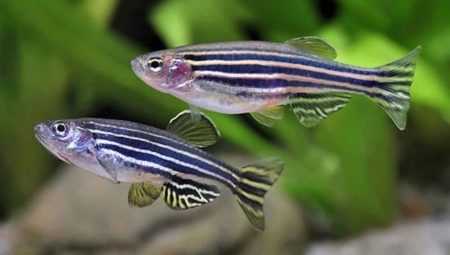Beginner aquarists filling their first tank are advised to turn their attention to the zebrafish. The appearance of such creatures looks extremely attractive and even spectacular, and caring for them is considered quite simple.
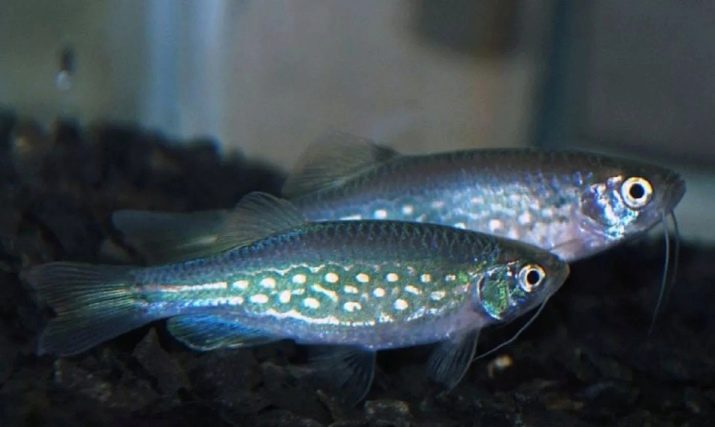
Description
The zebrafish is a representative of the cyprinid family, which is small in size. In nature, it lives in the calm reservoirs of Southeast Asia, as well as in rice fields. The length of the fish does not exceed 6 centimeters. The body is rather narrow and elongated, and the head is small.
The mouth is at the top, which allows the creature to eat, consuming food directly from the surface of the water. The zebrafish has two pairs of antennae that are responsible for touch.

Small fins, as a rule, are devoid of any pigment. The color of different types of zebrafish is different, but almost all representatives have horizontal stripes of blue or purple hue on the entire surface of the body. In bright light, these stripes shimmer beautifully. The body itself can be called translucent, with the ability to change color depending on the changing environment. The back most often has an olive-gray color, and the sides are painted silver-pink.
At home, zebrafish can live from 3 to 4 years, but larger varieties can increase this period to 5-7 years.
The cost of one individual varies from approximately 20 to 140 rubles, depending on the rarity of the species.
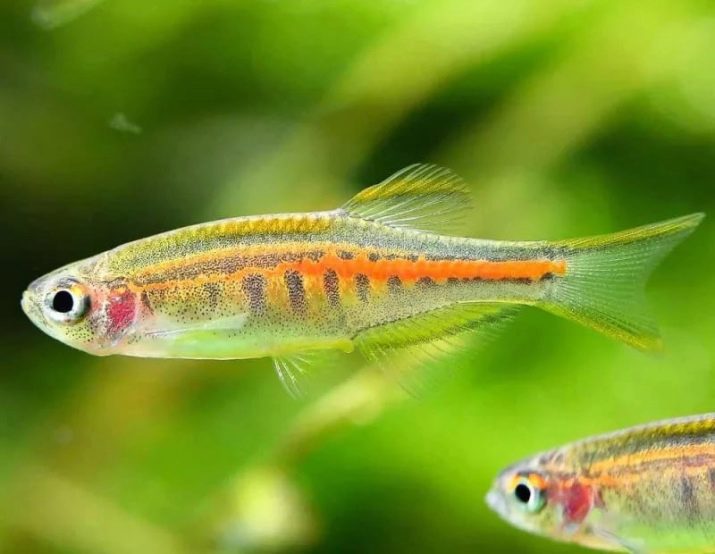
Growing conditions
Maintaining and caring for your zebrafish is not particularly difficult. It is customary to lodge fish in schools consisting of 5 or 6 individuals.
Aquarium Requirements
The tank will need quite large - for a flock of 5 individuals, from 50 to 100 liters are needed. A smaller number of fish, in principle, will be located in a smaller tank, but in this case, collisions and aggressive antics of neighbors are quite likely. In any case, the volume of the aquarium from 10 to 30 liters is considered too small. The shape of the vessel is better to choose elongated, close to the oval.
At the bottom of the tank, it is necessary to evenly distribute gravel or sand, previously thoroughly washed.
It is more convenient to plant plants around the perimeter so that underwater residents do not experience any problems with movement. Selected samples should not be too thick. The zebrafish is quite active and constantly in motion, so as few as possible disturbing objects, for example, decor, should be in the aquarium. However, a few cumbersome shelters will even be useful, as sometimes pets have a need to hide.

It is important to mention that active fish quite often jump out of the water.
If you do not take care of the lid in a timely manner, then in one day the situation can end fatally. The cover for the aquarium must have ventilation holes. In addition, you will have to leave at least a 5-centimeter gap between the water level and this part, otherwise the pets will start to hit the top of the tank. Most of the time, fish live either in the upper or in the middle of the aquarium. Nevertheless, sometimes they prefer to hide at the bottom in the sand, which explains the need for the formation of a sand layer.
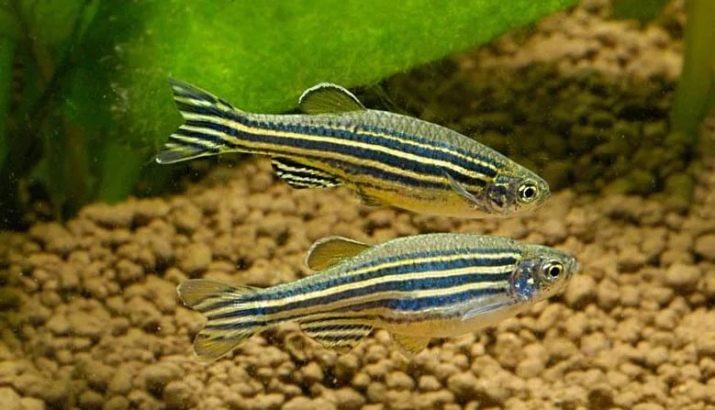
There is no special need for constant aeration, but the lighting for zebrafish must be of high quality. The optimal daylight hours range from 10 to 12 hours. If this indicator decreases, then the behavior of the fish and even their appearance will change for the worse. An important role in this matter is played by the location of the aquarium in the room, and by providing it with additional lights.
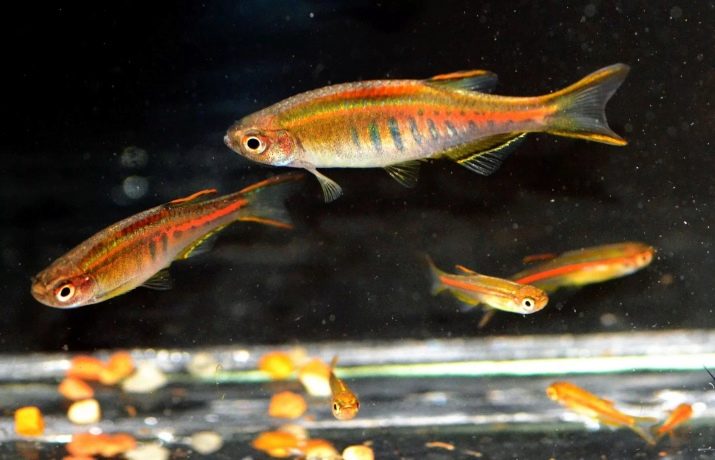
Water
The tank can be filled with tap water, but previously still settled for 12 hours. Its temperature can range from 22 to 26 degrees Celsius, and the pH level can be in the range of 6.5 to 7.5. Optimal dH does not go beyond 5-15. Inside the tank must be located a filter, compressor and lighting fixtures. Additionally, you can place and thermometerto always be sure of the optimum temperature.

The fish is not recommended to be launched into the aquarium until the required nitrogen cycle is established.
Besides, it is important to monitor the concentration of nitrites, nitrates and ammonia in water. Although maintaining a temperature profile for zebrafish is important, small fluctuations will not do them much harm. But the purity of the water is critical, so once a week it must be replaced by about a third of the total volume of the tank. Once a month, an aquarium will have to be cleaned.
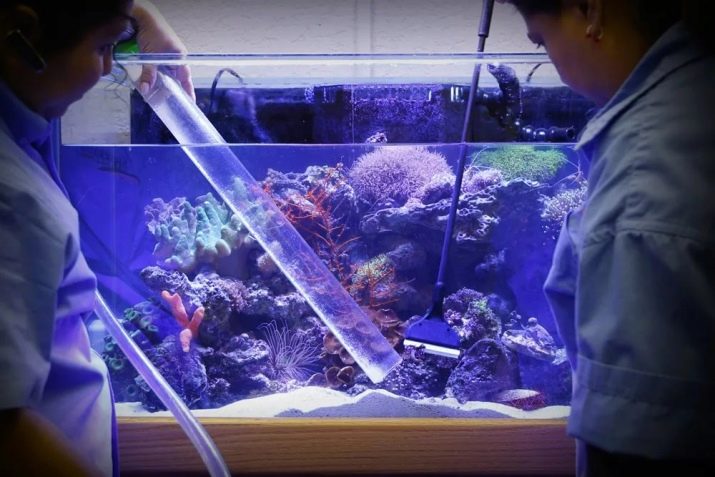
Feeding
In nature, zebrafish use zooplankton, insects and larvae, as well as seeds falling directly into the water. At home, both live and dry food can be used, but most of all the fish are located for eating bloodworms, tubule and artemia. It is important that all food that enters the aquarium is pre-crushed, otherwise underwater inhabitants will not be able to swallow it.
Avoid heavy feeds that immediately sink to the bottom: since the fish’s mouth is on top, they don’t even pay attention to bottom treats.
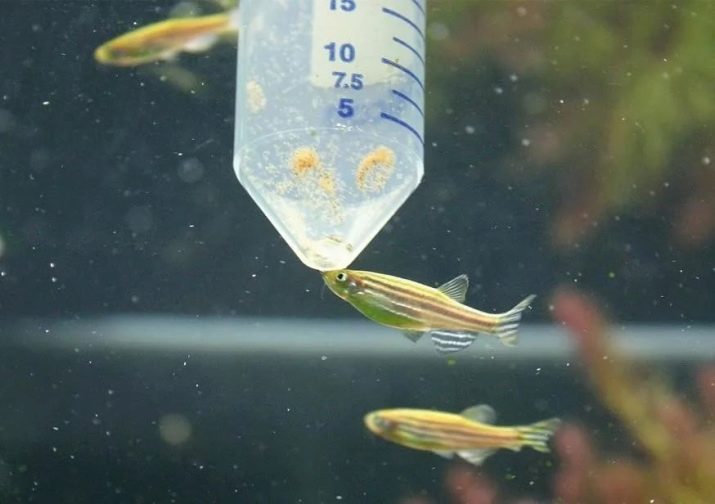
It is common for zebrafish to contract several well-known diseases. Plistophorosis characterized by the presence of white spots on the body, which eventually become sores. The fish is losing weight painfully, its fins look disheveled, and the movement occurs at an angle of 45 to 90 degrees.In this case, in addition to treatment, it is necessary to disinfect the aquarium, having previously cleaned it of soil, using a five percent solution of hydrochloric acid or bleach.
Medicines are added directly to the feed.
It could be trichopolum in the amount of 5 mg per liter of water, erythrocyclinewhich is used in a proportion of 50 mg per liter of liquid. Also can be used methylene blue solution - in this case, 10 mg per liter of water will be required. If the drugs do not work, then, unfortunately, the fish will have to be destroyed.
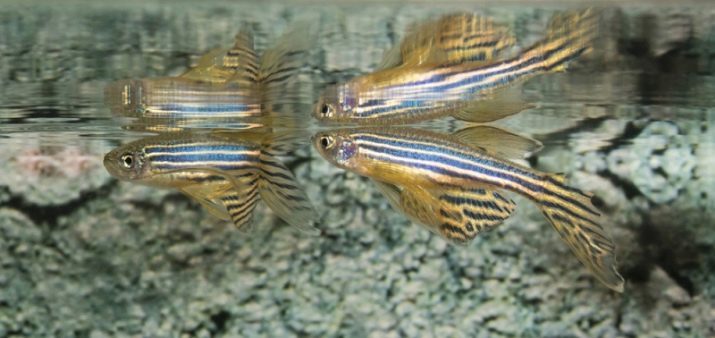
Trichodiniasis zebrafish can become infected due to ciliates. A gray plaque covering the entire body signals the disease. For treatment, the temperature in the aquarium will have to be increased to 31 degrees, and aeration will be significantly increased. Ordinary table salt is added directly to the water so that 10 liters per tablespoon of powder. As a rule, it should take from 10 days to a month for the zebrafish to completely recover, and all this time the salt concentration should remain unchanged.

Features of caring for different types
All aquarium varieties of zebrafish become an aquarium decoration thanks to the original, and sometimes exotic coloring. Leopard zebrafish is covered with specks resembling the skin of the same animal. This variety was obtained by breeders.
Danio rerio is the most popular and famous representative of the species. It can be identified by its yellowish body and neat black-and-blue stripes extending to the caudal and anal fins. The body length reaches only 5 centimeters.
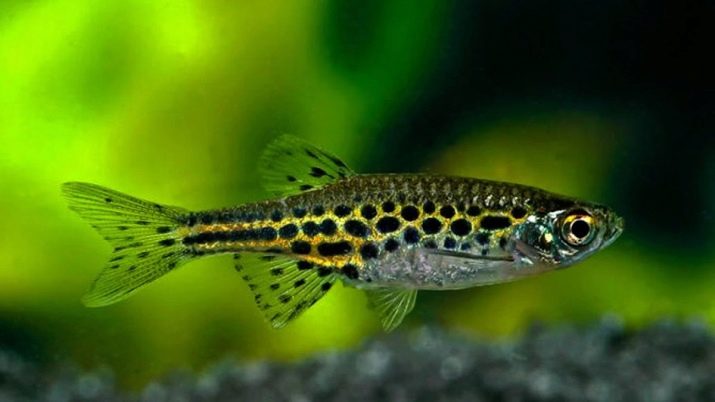
Pink zebrafish (pearl) is a small fish whose body length is about 6 centimeters. The body is painted in a gray-olive shade, and the sides look a little brighter. Along the side of the body is a strip of red with a blue border that disappears over time. The anal fin is colored red, and the tail and dorsal fin are green. Pink zebrafish males are smaller, have a bright color and a cherry spot right in the middle of the caudal fin.
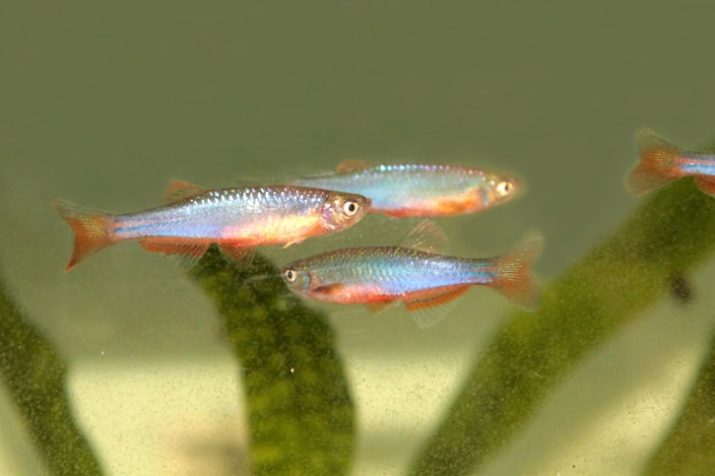
Firefly, also called hopra or chopra, is a small zebrafish whose length barely reaches 3 centimeters. Coloring fish is a combination of yellow and orange tones. This variety is also characterized by the presence of a solar strip extending from the head to the dorsal fin.
There is also fluorescent zebrafish resulting from the activities of breeders. A colored fish spreads around itself both ordinary white and ultraviolet light. The body length barely exceeds 3 centimeters, and the surface can be painted in shades from purple to bright red.

There are no special differences in the care of different zebrafish, but there are still some important nuances. For example, pink zebrafish and zebrafish feel comfortable at temperatures from 21 to 24 degrees. Hybrid species welcome and higher temperatures, reaching 30 degrees. Probably in this case a heater will be required inside the aquarium.
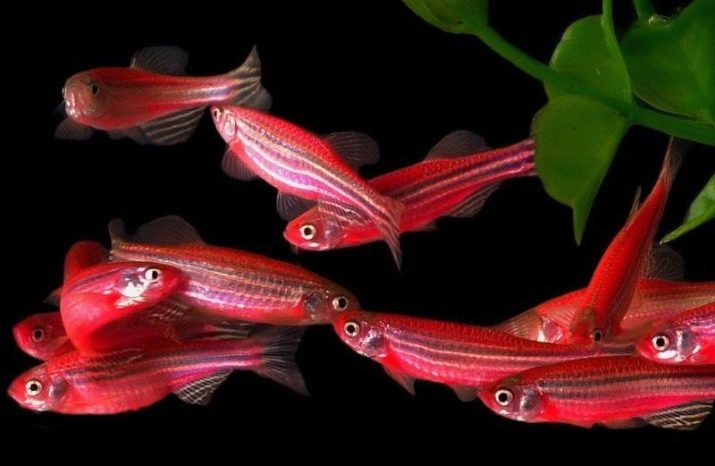
How to care for fry?
Danio caviar looks like small balls, painted in gray, the diameter of which does not exceed 0.7 mm. By the end of the spawning period, even a single female may have more than a hundred eggs, but not all of them will be fertilized as a result.
The first days the fry cannot even move - they simply sway in one place and consume the remains of their yolk sac.
But when they begin to move, it's time to feed them with ciliates or special powder formulations intended for fry. As soon as the zebrafish is 7 to 10 days old, you can offer them more complex food in the form of granules or flakes.
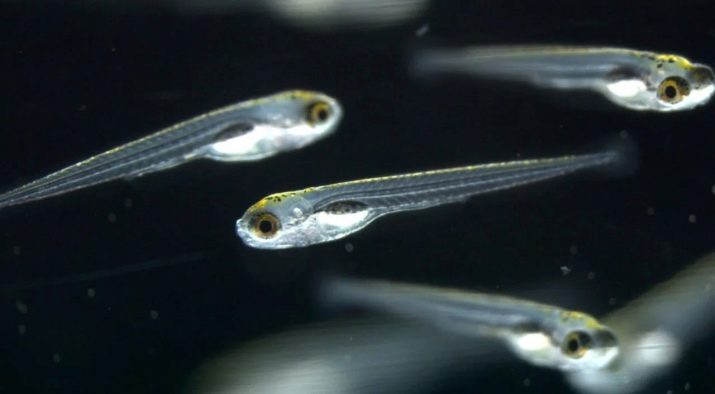
Compatibility
Due to the peaceful nature of the fish, zebrafish get along with numerous neighbors.For example, scalars, males, guppies, labeos, catfishes, bots and many other fish will become a good choice. Limited compatibility is observed with representatives of the underwater world such as shrimp, eels and barbs. It is strictly forbidden to settle zebrafish in the same tank with goldfish, cichlids, koi carps and discus.
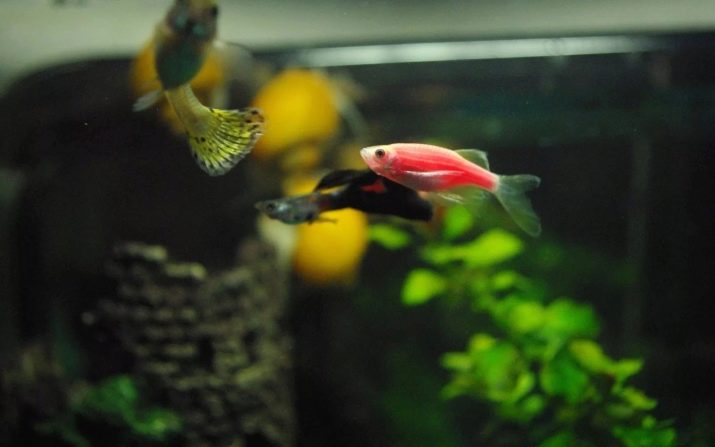
See the video below for tips on caring for pink zebrafish.
